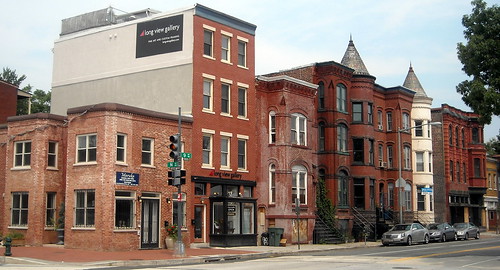 |
| Photo Credit: NCinDC |
Many residents who are feeling the affordability crunch on newly fashionable blocks may scoff at the question, but there is cause for anecdotal hope. In an interview with renowned urbanist Charles Leinberger, columnist Will Doig highlights the gentrification process of Albuquerque, N.M. and how the city created the Albuquerque Civic Trust. The Trust reinvests profits and increased property tax revenues from redevelopment into building and perserving affordable housing. Other examples of affordable housing efforts that have accompanied gentrification (and arguably would not have occurred without gentrification) include Portland's Interstate Alliance to End Displacement, which includes rental assistance, Real Estate Transfer Taxes (RETTs) to provide revenue for affordable housing creation that matches demand and Harlem Community Congregations, which works to acquire vacant land in rapidly redeveloping Upper Manhattan in order to construct affordable housing units. Even in Brooklyn's Park Slope, a pricy neighborhood long thought to be in the well-buffed clutches of Patagonia-clad couples pushing Maclaren prams, the Fifth Avenue Committee has partnered with the citywide public-private Community Preservation Corp. to build affordable housing, rehabilitate affordable units, and has defended tenants from eviction as part of the Displacement Free Zone campaign. Broadly speaking, strategies to reconcile gentrification and affordable housing have included inclusionary zoning (IZ), incentive zoning, RETTs, and, increasingly, community benefits agreements (CBAs) that legally require a developer to provide specific amenities and/or mitigations to a neighborhood to allay concerns related to gentrification.
On a more micro-level, community organizations in gentrifying hotspots like Portland's Alberta Arts District and Eckington and Bloomingdale in Washington, D.C. have initiated meaningful neighborhood dialogues between longtime residents and newcomers in an attempt to reduce friction and increase mutual understanding in these shared spaces. Gentrification may have its pitfalls, but the trend toward a more urban population and the "discovery" of new addresses by self-styled pioneers point to its endurance as a social and economic force. Efforts to bring developers and affordable housing advocates together may be the best way to encourage understanding between gentrifiers and long-time residents and reach solutions that allow economic diversity in the redeveloped, and often quite charming, sites of gentrification.
Note: Future posts will provide a more in-depth look at community based agreements and their relationshop to affordable housing.
No comments:
Post a Comment